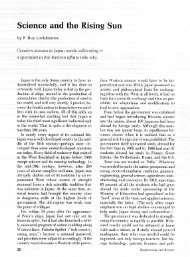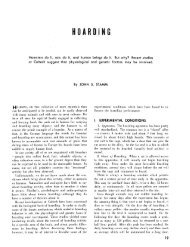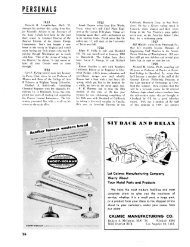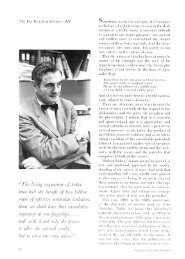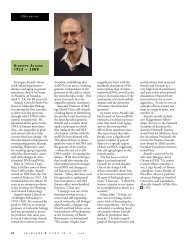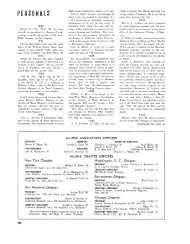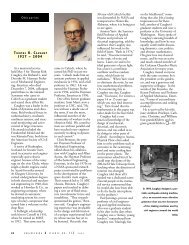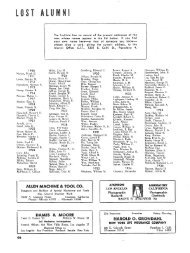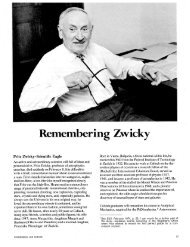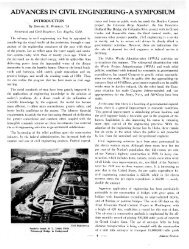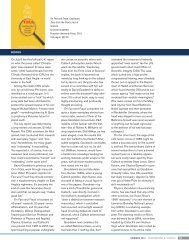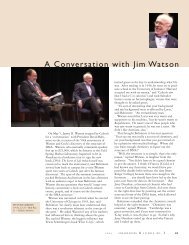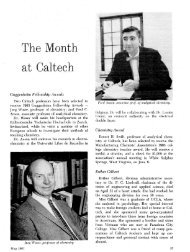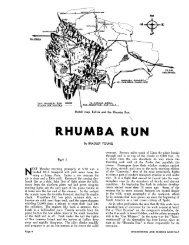published at the california institute of technology - Engineering ...
published at the california institute of technology - Engineering ...
published at the california institute of technology - Engineering ...
Create successful ePaper yourself
Turn your PDF publications into a flip-book with our unique Google optimized e-Paper software.
The ROO~S . . . continued<br />
President Edwards was willing to see <strong>the</strong> Normal<br />
and Commercial schools go, but fought hard to save<br />
<strong>the</strong> Academy and <strong>the</strong> Grammar School. Arthur<br />
Chamberlain, dean <strong>of</strong> <strong>the</strong> Normal School, would<br />
sacrifice all schools except his own, which he en-<br />
visioned as <strong>the</strong> future "Teachers' College <strong>of</strong> Colum-<br />
bia <strong>of</strong> <strong>the</strong> West." Both <strong>of</strong> <strong>the</strong>se men l<strong>at</strong>er resigned in<br />
disappointment and bitterness as <strong>the</strong> schools <strong>the</strong>y<br />
worked to save became casualties <strong>of</strong> Throop's grad-<br />
ual conversion into a college.<br />
In April 1907 <strong>the</strong> trustees took <strong>the</strong>ir first <strong>of</strong>ficial<br />
step toward college st<strong>at</strong>us when <strong>the</strong>y voted "to make<br />
Throop Institute a high-grade technical school." Its<br />
first department was to be a college <strong>of</strong> electrical en-<br />
qineering. A month l<strong>at</strong>er <strong>the</strong>y passed a motion th<strong>at</strong><br />
"<strong>the</strong> elementary school should be removed before<br />
next year." Two months l<strong>at</strong>er <strong>the</strong>y appointed a new<br />
president, James A. B. Scherer, <strong>at</strong> a salary <strong>of</strong> $5,000.<br />
George Ellery Hale was <strong>the</strong> moving spirit behind<br />
all this change. It was Hale who found Throop its<br />
new president. He met Scherer on shipboard when<br />
<strong>the</strong>y were both on <strong>the</strong>ir way to Europe in <strong>the</strong> spring<br />
<strong>of</strong> 1907. Scherer, an ordained Lu<strong>the</strong>ran minister,<br />
was <strong>at</strong> th<strong>at</strong> time president <strong>of</strong> Newberry College in<br />
South Carolina. He was an authority on Japan,<br />
where he had served five years as a missionary. Fol-<br />
lowing his missionary service, he became pastor <strong>of</strong><br />
<strong>the</strong> First Lu<strong>the</strong>ran Church in Charleston, South<br />
Carolina, and <strong>the</strong>n president <strong>of</strong> <strong>the</strong> little Lu<strong>the</strong>ran<br />
college in Newberry.<br />
This was an improbable background for a presi-<br />
dent <strong>of</strong> a science and engineering college, but Hale<br />
recognized in Scherer o<strong>the</strong>r qualities to recommend<br />
him for <strong>the</strong> position. He was famous as <strong>the</strong> gre<strong>at</strong>est<br />
or<strong>at</strong>or in <strong>the</strong> South; he had been a successful fund-<br />
raiser and builder during his administr<strong>at</strong>ion <strong>at</strong> New-<br />
berry; and he was a promoter who was willing to<br />
take <strong>the</strong> tremendous gamble to "start all over." Ac-<br />
cording to Hale's widow, Hale decided th<strong>at</strong> since<br />
<strong>the</strong> first goal <strong>of</strong> <strong>the</strong> school was simply to survive, it<br />
Pasc~d~~ruz Hall (Throop) under construction in 1910.<br />
would do well to have an aggressive young president<br />
like Scherer and to recruit outstanding engineers<br />
and scientists for <strong>the</strong> faculty.<br />
Scherer was inaugur<strong>at</strong>ed on November 19, 1908.<br />
During <strong>the</strong> next two years, <strong>the</strong> Institute elimin<strong>at</strong>ed<br />
all schools except <strong>the</strong> Academy and <strong>the</strong> College. On<br />
<strong>the</strong> strong recommend<strong>at</strong>ion <strong>of</strong> President Scherer,<br />
<strong>the</strong> trustees decided to keep <strong>the</strong> Academy on a twoyear<br />
trial basis. Their serious intention to continue<br />
<strong>the</strong> Academy is indic<strong>at</strong>ed by <strong>the</strong> fact th<strong>at</strong> <strong>the</strong>y<br />
commissioned Myron Hunt to build a student<br />
residence hall on <strong>the</strong> North Los Robles property<br />
th<strong>at</strong>, before it was finished, cost $45,000. (The is same<br />
building was l<strong>at</strong>er moved to <strong>the</strong> present campus and<br />
used as The Old Dorm and The Greasy Spoon until<br />
it was replaced by Winnett Center.)<br />
But Throop Academy was doomed, for by 1911<br />
<strong>the</strong>re were 30 polytechnic high schools in sou<strong>the</strong>rn<br />
California. The final blow came when Pasadena<br />
voted a $475,000 bond issue to establish a polytechnic<br />
high school <strong>of</strong> its own. On April 8, 1911, <strong>the</strong><br />
board voted to discontinue <strong>the</strong> Academy.<br />
Scherer sincerely believed in <strong>the</strong> pioneering<br />
developnlent <strong>of</strong> a first-class college <strong>of</strong> science and<br />
engineering in burgeoning sou<strong>the</strong>rn California,<br />
and he was challenged by <strong>the</strong> opportunity to<br />
help cre<strong>at</strong>e "something entirely new in American<br />
educ<strong>at</strong>ion." "Here shall be a school," he wrote, "content<br />
with nothing lower than <strong>the</strong> best; resolved to<br />
set itself fixedly toward its ideas regardless <strong>of</strong> educ<strong>at</strong>ional<br />
tradition when <strong>the</strong>se might hamper its<br />
growth, yet eager to conserve wh<strong>at</strong>ever may help<br />
it forward in fulfillment <strong>of</strong> its destiny."<br />
The proposed combining <strong>of</strong> <strong>the</strong> humanities with<br />
engineering and science was <strong>the</strong> <strong>the</strong>me <strong>of</strong> many <strong>of</strong><br />
his public addresses. "You and I shall see it in our<br />
day," he said, "when Oxford shall shake hands with<br />
Pittsburgh."<br />
In his first address to his faculty, he said, "It is<br />
<strong>the</strong> ambition <strong>of</strong> <strong>the</strong> government <strong>of</strong> Throop so to correl<strong>at</strong>e<br />
arid unify a course <strong>of</strong> study as to add, eventually,<br />
something new and vital to educ<strong>at</strong>ional policies<br />
in America . . . It is hoped th<strong>at</strong> every man in<br />
<strong>the</strong> faculty may have time for individual research.<br />
Throop will be measured in <strong>the</strong> educ<strong>at</strong>ional world<br />
precisely as it succeeds or fails in this particular."<br />
Architect Myron Hunt visited 25 American campuses<br />
before completing his plans for Throop's<br />
building program. On February 21, 1908, <strong>the</strong> Los<br />
Angeles Times reported: "Plans for an educ<strong>at</strong>ional<br />
plant to cost between $2,000,000 and $3,000,000<br />
and to surpass all existing institutions <strong>of</strong> <strong>the</strong> kind<br />
in <strong>the</strong> world will be submitted to <strong>the</strong> Trustees <strong>of</strong><br />
4 <strong>Engineering</strong> and Science



